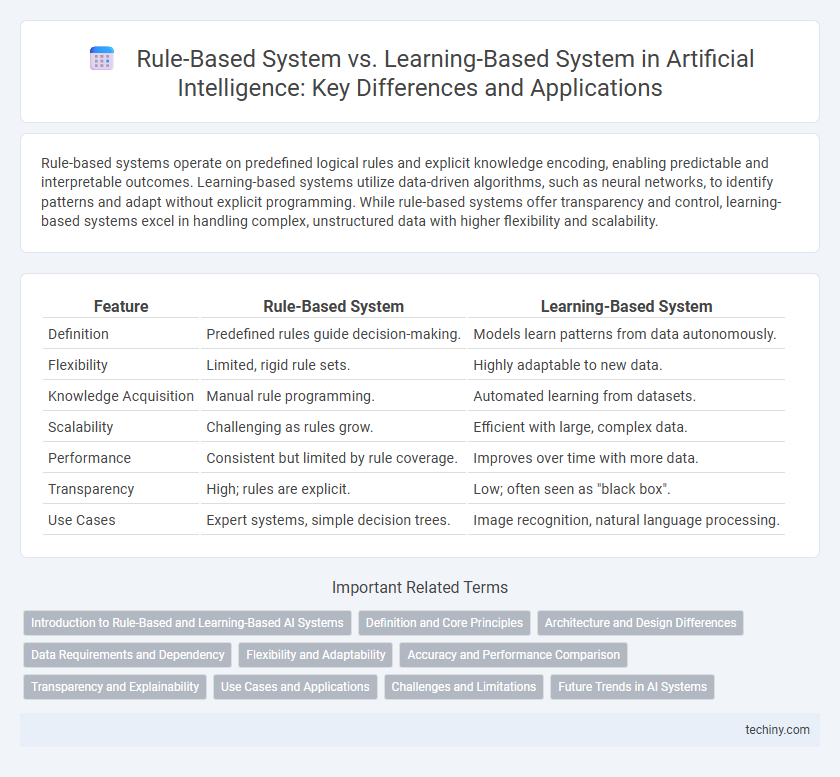Rule-based systems operate on predefined logical rules and explicit knowledge encoding, enabling predictable and interpretable outcomes. Learning-based systems utilize data-driven algorithms, such as neural networks, to identify patterns and adapt without explicit programming. While rule-based systems offer transparency and control, learning-based systems excel in handling complex, unstructured data with higher flexibility and scalability.
Table of Comparison
| Feature | Rule-Based System | Learning-Based System |
|---|---|---|
| Definition | Predefined rules guide decision-making. | Models learn patterns from data autonomously. |
| Flexibility | Limited, rigid rule sets. | Highly adaptable to new data. |
| Knowledge Acquisition | Manual rule programming. | Automated learning from datasets. |
| Scalability | Challenging as rules grow. | Efficient with large, complex data. |
| Performance | Consistent but limited by rule coverage. | Improves over time with more data. |
| Transparency | High; rules are explicit. | Low; often seen as "black box". |
| Use Cases | Expert systems, simple decision trees. | Image recognition, natural language processing. |
Introduction to Rule-Based and Learning-Based AI Systems
Rule-based AI systems operate using predefined logical rules and symbolic reasoning to make decisions, making them transparent and easy to debug. Learning-based AI systems, such as neural networks, rely on large datasets to learn patterns and improve performance over time through training processes. Both approaches represent fundamental paradigms in artificial intelligence, with rule-based systems excelling in domains requiring explicit knowledge representation and learning-based systems thriving in tasks involving complex data-driven pattern recognition.
Definition and Core Principles
Rule-Based Systems operate on predefined logical rules and symbolic reasoning, leveraging expert knowledge encoded in if-then statements to make decisions. Learning-Based Systems, such as neural networks and machine learning algorithms, derive patterns and improve performance from data through training without explicit programming of rules. Core principles of Rule-Based Systems emphasize deterministic control flow and knowledge engineering, while Learning-Based Systems rely on statistical inference and adaptability to new information.
Architecture and Design Differences
Rule-based systems feature a predefined set of logical rules and decision trees, relying on explicit knowledge representation and deterministic processing for problem-solving. Learning-based systems utilize neural networks or machine learning algorithms that adapt through data training, enabling probabilistic reasoning and pattern recognition. The architecture of rule-based systems emphasizes fixed inference engines and rule databases, whereas learning-based systems prioritize model training, feature extraction, and continuous improvement through data input.
Data Requirements and Dependency
Rule-based systems rely heavily on expert knowledge and predefined rules, requiring minimal data but extensive manual input to encode domain-specific logic. Learning-based systems depend on large, high-quality datasets to automatically infer patterns and adapt over time, making their performance heavily data-dependent. The effectiveness of learning-based models improves with increased data volume and diversity, whereas rule-based systems remain static unless manually updated.
Flexibility and Adaptability
Rule-Based Systems operate on predefined logic and fixed rules, limiting their flexibility in handling unanticipated scenarios and requiring manual updates for new conditions. Learning-Based Systems leverage algorithms such as neural networks and reinforcement learning to dynamically adapt to new data patterns, enhancing their adaptability and performance over time. This intrinsic ability to learn from experience makes Learning-Based Systems more suitable for complex, evolving environments where flexibility is crucial.
Accuracy and Performance Comparison
Rule-based systems deliver consistent accuracy in well-defined scenarios by applying predefined logic and explicit rules, but they struggle with complex or ambiguous data. Learning-based systems, especially deep learning models, achieve superior accuracy and adaptability by extracting patterns from large datasets, enhancing performance in dynamic and unstructured environments. Performance metrics frequently show learning-based models outperform rule-based counterparts in tasks like image recognition and natural language processing due to their ability to generalize and improve from data.
Transparency and Explainability
Rule-based systems offer high transparency and explainability since their decision-making process follows predefined rules easily interpretable by humans. Learning-based systems, such as neural networks, often exhibit lower transparency due to complex model architectures and opaque decision pathways, posing challenges for explainability. Techniques like SHAP values and LIME are used to improve interpretability in learning-based models to provide insights into their predictions.
Use Cases and Applications
Rule-Based Systems excel in environments requiring clear, predefined logic such as expert systems for medical diagnosis and automated customer support chatbots. Learning-Based Systems, leveraging machine learning models, thrive in dynamic applications like speech recognition, fraud detection, and recommendation engines where adaptability to new data is crucial. Hybrid approaches combining rule-based precision and learning-based flexibility are increasingly applied in autonomous driving and complex decision-making systems to enhance accuracy and responsiveness.
Challenges and Limitations
Rule-based systems in artificial intelligence face challenges such as rigid logic, limited scalability, and difficulty in handling ambiguous or incomplete data, restricting their adaptability to complex real-world scenarios. Learning-based systems, while more flexible, encounter limitations including high computational costs, dependency on large labeled datasets, and risks of overfitting or biased outcomes due to training data quality. Both approaches must navigate trade-offs between interpretability and performance, impacting their effectiveness in dynamic AI applications.
Future Trends in AI Systems
Future trends in AI systems indicate a shift from traditional rule-based systems toward advanced learning-based systems driven by deep learning and neural networks. Learning-based models demonstrate superior adaptability and scalability by continuously improving from vast datasets, enabling more complex decision-making and natural language understanding. Emerging hybrid approaches integrate rule-based frameworks with learning algorithms to enhance transparency and reliability, addressing key challenges in explainability and ethical AI development.
Rule-Based System vs Learning-Based System Infographic

 techiny.com
techiny.com